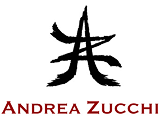Marco Meneguzzo, The poles of painting, catalogo della mostra / exhibition catalogue, Galleria Annovi, Sassuolo (Modena).
Painting has often been fond of places distant in time and space. Exoticism was born when this perception was consolidated and declared, that is, when the subject matter that was “close” could be registered, analysed and measured – perhaps via photography, at the height of the bourgeois era. Exoticism was a place that existed but that was almost inaccessible, a theatre of extraordinary happenings that were simply the projection of the desires of those who were living in a world that was already too controlled.
Does exoticism still exist? The answer would seem to be yes, if you look at the recent cycle of paintings by Andrea Zucchi, of savannahs with rhinoceroses and now, polar landscapes. And yet, if the exotic signifies only what is “distant”, the notion would have long been exhausted. It would have been rejected and erased by the horizon of our minds and senses and by virtue of a millimetric knowledge of the planet provided by millions of documentary images, the vanguard of millions of tourists.
Nonetheless, it is not the ice of Polar regions or the expanses of Africa which generate the sensation of the exotic, or of the “extraordinary”. Rather, it is the presence of painting. More than any other subject, painting has become “exotic” by the simple fact that it is (still) used. The medium and practice of painting and the knowledge that painters exist who work (almost) as they did five hundred years ago is what renders mysterious, fabulous and distant that which we would feel to be quite close if captured by any other means. In this recent cycle by the young Milanese artist, which deals with a place as distant as the Pole (and which of the two Poles is not important), there is an image of a polar bear jumping onto a piece of ice floe. It seemed clear to me that Zucchi had photographed the scene, and in order to confirm this I asked him to show me the photograph. It is a beautiful, glossy sequence of four photos capturing the animal’s strength. However, the point did not lie there, it lay in the fact that the pictorial image conferred on that very dynamic movement an almost metaphysical intentness that excluded any of that action’s before or after from the mind. It cancelled the instant and conferred on the image that suspension that has within it the mystery of a story, which revives a sense of remoteness and makes one dream instead of see.
In order not to concede too much to a romantic spirit (which moreover is well illustrated by a citation from Caspar David Friedrich) it must be said that Zucchi’s work, at the point when it is most evocative, introduces into the painting – intended as both painting and “screen” – a perceptive “interference”, a series of square, rectangular and absolutely geometric elements. These make the artist speak of Mondrian and Neoplasticism (though is it not a type of neoplastic formation of the image, namely, the cancer that corrodes it from within its very own language?) as an unavoidable reference to what painting has become, once the “innocence” of representation has been lost. As such all of Zucchi’s paintings are “polar” in the sense that they move between the two poles of painting, the iconic and the aniconic, with all the corollaries that these linguistic magnets bring with them: narrativity and auto-referentiality, pleasure and purity, and the concrete and abstract (where the abstract is obviously figurative representation, and the concrete the materialisation of geometric forms). As a consequence, the great challenge for Zucchi is balance, and to achieve it he does not hesitate in harnessing all the artifices and conceits of painting, without favouring any one. Indeed long gone is the age in which the artist fulfilled an apprenticeship through all the phases of the symbolic, the oneiric and the surreal, today all veiled behind a great indifference to narrative and the choice of subject matter (…“icebergs began to interest me”, Andrea told me “because of the play of light and the iridescent reflections on water and on the white surfaces…”, that is to say, that adventure in extreme situations is not the main theme of the choice of the Polar subject). Moreover, the practice of painting no longer consumes itself within itself, but once balance is found internally through the tension between its two poles, the painting projects itself outside its own language. Once again this is not by virtue of the narrative evoked by the subject, but is due to the act of image interference, which is simultaneously internal and external to painting. If indeed it is legitimate to evoke Mondrian, it is perhaps even more immediate to think of a kind of difficulty of reception, of image transmission interference, as occurs when monitor screens are unable to cope with the speed and weight of the requisite bites. The surface of the painting thus becomes a screen, and painting “mimics”, jeeringly, electronic communication, even though it well knows that any notion of “mimesis” applied to itself is nothing more than another attempt at defining itself.

